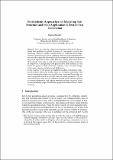| dc.contributor.author | Barzilay, Regina | |
| dc.date.accessioned | 2012-08-30T15:54:46Z | |
| dc.date.available | 2012-08-30T15:54:46Z | |
| dc.date.issued | 2010-08 | |
| dc.identifier.isbn | 978-3-642-15572-7 | |
| dc.identifier.issn | 0302-9743 | |
| dc.identifier.issn | 1611-3349 | |
| dc.identifier.uri | http://hdl.handle.net/1721.1/72468 | |
| dc.description.abstract | Since the early days of generation research, it has been acknowledged that modeling the global structure of a document is crucial for producing coherent, readable output. However, traditional knowledge-intensive approaches have been of limited utility in addressing this problem since they cannot be effectively scaled to operate in domain-independent, large-scale applications. Due to this difficulty, existing text-to-text generation systems rarely rely on such structural information when producing an output text. Consequently, texts generated by these methods do not match the quality of those written by humans – they are often fraught with severe coherence violations and disfluencies.
In this chapter, I will present probabilistic models of document structure that can be effectively learned from raw document collections. This feature distinguishes these new models from traditional knowledge intensive approaches used in symbolic concept-to-text generation. Our results demonstrate that these probabilistic models can be directly applied to content organization, and suggest that these models can prove useful in an even broader range of text-to-text applications than we have considered here. | en_US |
| dc.description.sponsorship | National Science Foundation (U.S.) (CAREER grant IIS- 0448168) | en_US |
| dc.description.sponsorship | Microsoft Research. New Faculty Fellowship | en_US |
| dc.language.iso | en_US | |
| dc.publisher | Springer-Verlag | en_US |
| dc.relation.isversionof | http://dx.doi.org/10.1007/978-3-642-15573-4_1 | en_US |
| dc.rights | Creative Commons Attribution-Noncommercial-Share Alike 3.0 | en_US |
| dc.rights.uri | http://creativecommons.org/licenses/by-nc-sa/3.0/ | en_US |
| dc.source | MIT web domain | en_US |
| dc.title | Probabilistic approaches for modeling text structure and their application to text-to-text generation | en_US |
| dc.type | Article | en_US |
| dc.identifier.citation | Barzilay, Regina. “Probabilistic Approaches for Modeling Text Structure and Their Application to Text-to-Text Generation.” Empirical Methods in Natural Language Generation. Ed. Emiel Krahmer & Mariët Theune. Vol. 5790. Berlin, Heidelberg: Springer Berlin Heidelberg, 2010. 1-12. | en_US |
| dc.contributor.department | Massachusetts Institute of Technology. Department of Electrical Engineering and Computer Science | en_US |
| dc.contributor.approver | Barzilay, Regina | |
| dc.contributor.mitauthor | Barzilay, Regina | |
| dc.relation.journal | Empirical Methods in Natural Language Generation | en_US |
| dc.eprint.version | Author's final manuscript | en_US |
| dc.type.uri | http://purl.org/eprint/type/ConferencePaper | en_US |
| dspace.orderedauthors | Barzilay, Regina | en |
| dc.identifier.orcid | https://orcid.org/0000-0002-2921-8201 | |
| mit.license | OPEN_ACCESS_POLICY | en_US |
| mit.metadata.status | Complete | |
